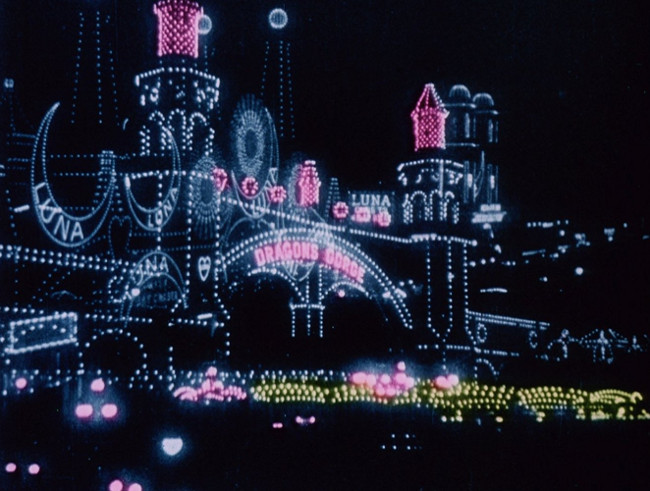A striking picture from a unique moment in Hollywood history, Pál Fejös’ 1928 romantic drama Lonesome found itself one of the first transitional films between the silent and sound/talkie era.
Originally developed as a Universal silent feature by the Hungarian filmmaker (Fejös, a Renaissance man, was also a doctor, World War 1 medic, anthropologist and explorer), in post-production it was decided that three dialogue scenes would be added – to appease audiences who desired the new effect following The Jazz Singer craze. A short transitional period of about two years followed, as filmmakers and studios began to adapt to the changing world of sound, adding touches of dialogue into their silent pictures.
A simple, mirrored tale of two lonely individuals trudging through chaotic life in lively New York City, Mary (Barbara Kent), a telephone operator, and Jim (Glenn Tryon), a factory worker, are both young singles with countless friends who are all in happy relationships. Getting off work early on Saturday, both are drawn to Coney Island and the beach (Venice, California a stand in for the New York amusement park – other than some stock footage of the locale) by a promotional musical float that is touring the city.
Spotting each other in the chaotic crowd, Mary plays an intricate game of cat and mouse, playing hard to get as she meanders through the busy location, forcing Jim to track her like an animal stocking its prey. There is magic in the air, life in the flickering lights of Luna Park, heart in their surroundings, bringing the pair together – a fugue state of love they have never experienced before. But, after a freak accident, they are separated without knowing the others’ name or address. Will they ever find each other again in the hugely populated city that is The Big Apple?
Masterfully shot using a bevy of creative techniques, the drastic change that occurs after their separation is the first thing that needs mention. Cinematographer Joseph Cherniavsky cools their surroundings as a storm hits the park. Feeling like the air is being let out of a balloon, suddenly the hustle and bustle of the people is frenetic, those employees that were once warm and welcoming are now ungracious and unhelpful, as the couple try to track each other down. It is hard to fathom how they ever found each other, the moving pieces and energetic din unruly, loss seeping into their souls as they remember the struggles they had before they met.
This countered the earlier warmth found in Cherniavsky’s cinematography and Fejös’ direction. They bring the park to life, utilizing hand stencilled colour tinting on the original prints to depict the vivid excitement of the island paradise. Fortunate that the motion picture has not been lost to time, we are unsure as to how much of the Luna Park segment was actually coloured – as the sole remaining original print was not exactly in the best shape (the song playing over the end credits cuts out before the end as well – showing once again, the wear and tear of the negative). Despite this, it still adds a fantastic element to these sequences. Each ride the couple enjoy is wonderfully filmed, giving us an idea of the excitement of making the trek to the amusement park.
Another unique touch finds the director using superimposition effects to capture the chaos of day to day life and the excitement of the amusement park. One example finds a clock placed around both leads as they complete their arduous tasks at work, highlighting just what their jobs entail.
Finding those little things that push the narrative forward (like the musical float mentioned above), a porcelain doll Jim wins for Mary symbolizes the emotional heft she is feeling as she flounders after losing him (the rain making it look like the figurine is crying). Likewise, button-pin photos taken at a booth, at first a comedic scene, later holds a different meaning as it is the only true memento they each have of the other. Irving Berlin’s song “Always”, the tune the duo danced to at the park, catches the eye of Jim as he hopelessly wanders through his apartment – putting the record on to try to find some solace in the raw memories, another example of these simple reminders of their wondrous albeit brief time spent together.
Depicting life in 1920s New York, the smells of the subway, the energy of Coney Island and the hectic chaos of the city is never more evident. Drawing a connection to another 1928 silent feature in Harold Lloyd’s Speedy, they both capture a key pastime of Americans in this era (no longer the same with the way the world has changed over the years). There is a fantastical quality to Lonesome, the enchanting sense that you can find someone to love in a city so packed that you likely don’t even know your own neighbour. Chance, luck and fate all play a role in love and life in this world. As a final note, you will notice that the bland dialogue scenes (that most critics dislike) are all filmed with a never moving camera, highlighting some of the issues that would crop up in the early talkies (the camera locked in spot to help capture the melodramatic sound – microphones so sensitive they would pick up every little noise – that would replace creative movement in a very short amount of time). It highlights the immense creativity that went into these silent films, the camera and actors movements well ahead of its time – things would become stagnant until the advancement in sound quality. Beautifully acted by two now forgotten actors, Lonesome is an exquisitely directed simple little love story with heart. . . so connect with this classic piece of hidden treasure that truly takes down the wall with sound.


